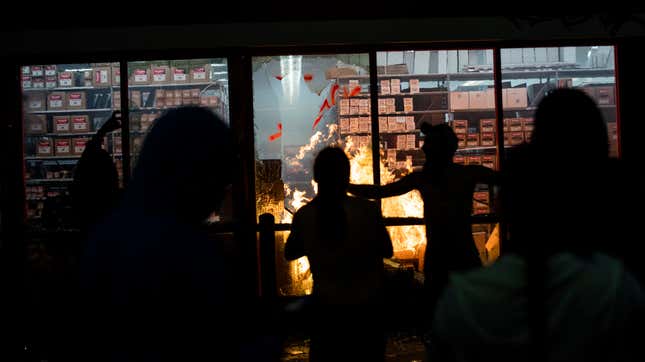This Is What You Get
Latest
Image: Getty
In August 2016, a small riot broke out following the death of Sylville K. Smith, a black man shot and killed by Milwaukee police. An auto parts store was aflame while a CBS reporter interviewed the victim’s brother. “We losing loved ones every day to the people that’s sworn in to protect us,” he said. “It’s not us, it’s the police. This is the madness that they spark up. This is what they encourage. This is what they provoke. This is what you get.”
Almost four years later, pockets of Minneapolis, Minnesota, are smoldering after two nights of protest against the city’s police. Many stores are a mess of glass and buildings were set ablaze. But a family is enjoying a new Instant Pot, a child gets to play with a new set of toys, and a household has a new vacuum cleaner thanks to an afternoon spent “looting” a local Target store, a scenario which, for some, is far more horrifying than the event that sparked this chaos in the first place: The death of a black man at the hands of a white police officer.
On Monday, George Floyd died after Officer Derek Chauvin held him down, kneeling on his neck for nine minutes. A viral video caught the incident, as well as Floyd’s cries that he couldn’t breathe, a haunting mirror to Eric Garner, who died when a police officer held him in a chokehold, ignoring his choked refrain: “I can’t breathe.”
Four officers involved in the Floyd incident—Chauvin, Thomas Lane, Tou Thao and J. Alexander Kueng—have been fired, and both Chauvin and Thao have been investigated—but never disciplined—for excessive force in the past. But there are calls for arrests by Floyd’s family, the Mayor of Minneapolis, and Congresswoman Ilhan Omar, none believing a pink slip is sufficient punishment. And in the absence of justice—which carceral punishment cannot fully alleviate—protests emerged. Hundreds took to the streets, creating a multiracial, multigenerational sea of righteous rage.
The pattern is easy enough to follow: A police officer is alleged to have killed an unarmed black person, a viral video emerges, protesters assemble, and the police respond to peaceful protest with suffocating tear gas and rubber bullets. By then, all bets are off, and so begin the fires and so-called “looting” while America’s moral arbiters play judge and jury.
While these critics include timid liberals who worry about optics of the protest above all else, the loudest naysayers have been right-wing scourges like Tucker Carlson, who said that the riots are worse than police brutality, and Charlie Kirk, who tweeted, “If you loot riot and destroy you lose all moral credibility, in my eyes, to protest injustice.” (Of course, Kirk was silent about Floyd’s death prior to the protests; it’s the destruction of property that inspired him to tweet, not Floyd’s untimely death.)
Property is inanimate. It doesn’t breathe, it doesn’t have hopes, dreams, or mouths to feed. There are properties we cherish—our homes, our places of worship, buildings of historical and cultural significance. A Target is not one of these places, and neither is an Arby’s, a Wendy’s, an Aldi, an Autozone, or an empty construction site. It’s safe to say that the aforementioned establishments are better insured than many Americans. But just as a destroyed CVS became a symbol of the unruliness of protesters in following the 2015 death of Freddie Gray, so too is the Minneapolis Target store that provided protesters with a sliver of catharsis in the face of an uncaring police force, an uncaring society.
For far too many Americans, it is easier to mourn the destruction of a series of chain stores, owned and operated by millionaires, than the death of a Black American. A stolen lamp is worthy of a kind of empathy that a black person could only dream of.
-

-

-

-

-

-

-

-

-

-

-

-

-

-

-

-

-

-

-

-

-

-

-

-

-

-

-

-

-

-

-

-

-

-

-

-

-

-

-

-








































